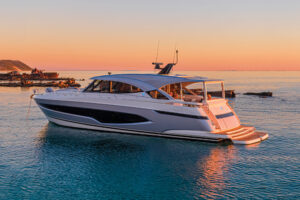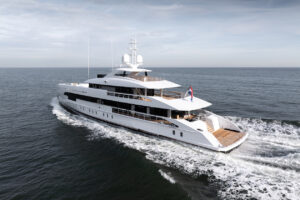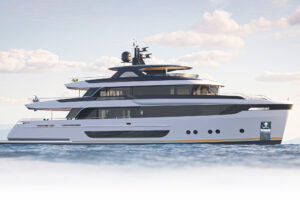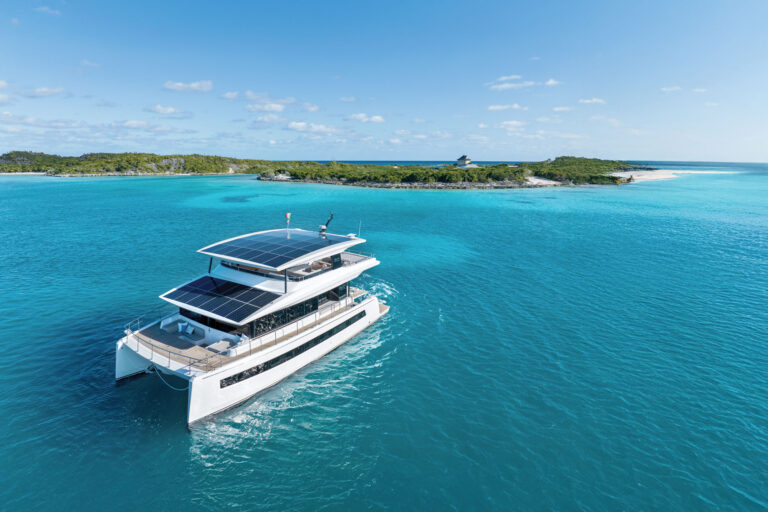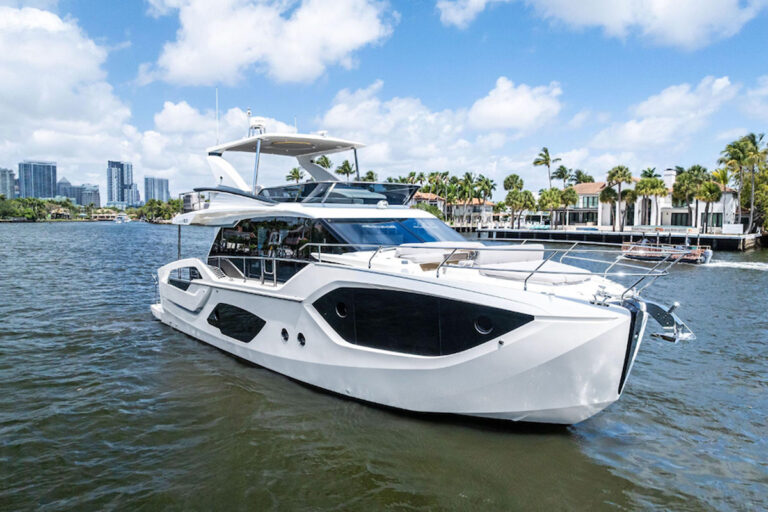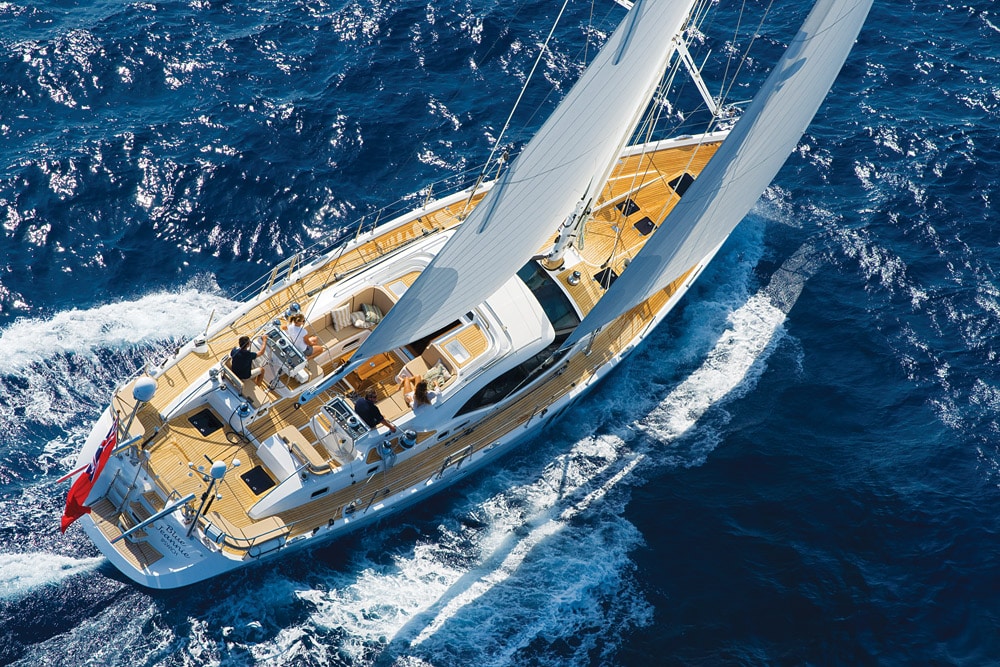
Oyster 625
Sailing an Oyster has always sparked my wanderlust, but it usually has gone into remission a day or two later. After sailing the new 625 off Miami, I fear that my wanderer’s disease has gone terminal. Even though we were in the warmth of Florida’s sun, visions of destinations among the high latitudes continuously looped through my brain as I steered her on a close reach in a moderate breeze. She loped along, flirting with her theoretical hull speed of 10 knots while we played with the mainsail and 150 genoa to hold our speed, in spite of the minute variations in the wind’s direction and strength. She responded quickly and accurately to changes in sail trim and input at the wheel. The rudder spoke to my hands via the wheel — a pleasant conversation that made me feel part of the boat.
Throughout most of Oyster Marine’s lifetime, it has stressed robust construction, high-quality equipment and joinery, and thoughtfully designed accommodations for its cruising yachts. Oyster was among the first to raise the amidships salon a couple of steps higher than the forward accommodations and enclose the area within a handsome deckhouse. The company’s brochures referred to this design as a “deck saloon,” the first of which, the 46 designed by Holman & Pye, splashed in 1980. Hull No. 9 of the 46, Leisurely Leo, was the first of many models to circumnavigate the globe. Other sailors on adventurous passages aboard their Oysters built the marque’s cachet as news of their exploits circulated among the cruising community. Although the early Oysters weren’t the fastest boats of the day, their relatively heavy displacement, fine entry and U-shape forefoot allowed them comfortably to maintain maximum speed over a wide range of conditions.
_Click here to see a full photo gallery of the Oyster 625._
The 625 replaces the popular 62, which Oyster developed from the 61 and built for about 10 years, and, like all the latest models up to 99 feet, came from the drawing board of Rob Humphreys. He established a reputation early in his career for designing fast racing boats, and he’s applied this talent to Oyster’s line. Beneath the waterline, the 625 still has a fine entry and U-shape sections forward, but her entire underbody is shallower than that of her predecessors. Even more important to speed and handling, though, is the substantial reduction in displacement.
Although these changes to the shape of the underbody and the lighter displacement give the 625 a livelier personality than her ancestors’, I was disappointed to see the mainsail unrolling from the mast. In the past, this type of mainsail didn’t have a great shape (often characterized by a hollow leech) and what shape it did have deteriorated with each roller-furled reef. In-mast furling still compromises the shape, but vertical battens and modern design and materials have reduced the disadvantages. I prefer the mainsail to have a substantial roach and full-length horizontal battens, but Oyster claims that most of its customers for the 625 have ordered in-mast furling, no doubt because it eases getting under way and reefing.
If I’d sailed her blind, I probably wouldn’t have noticed by feel that this yacht’s mainsail lived in the mast during its time off. Odd how prejudice fades away in the light of truth. You know, “if you can’t be with the one you love, love the one you’re with,” as Stephen Stills sang. I’ll wager that only a GPS could tell the difference in speed between our sea-trial boat and one with the standard rig.
Upwind, the 625 relies on her 150 genoa for the majority of drive. This sail’s clean leading edge and adjustable draft allow it to draw well over many points of sail, though tacking and jibing it can be a pain. Our experienced crew and powered winches made short work of handling the big headsail, and the 625 tacked as though she were smaller, quickly passing through stays. Catching her on the new tack at exactly the right moment spurred her into a deliberate, but satisfyingly quick, acceleration — as befits her role as a cruising yacht. We jibed her without drama in the light-to-moderate winds of the day, because we didn’t need the running backstays. In high winds and rough seas, the crew would have to jibe the runners, as well as tend the headsail.
In keeping with current philosophy, Oyster has divided the cockpit into a lounge just abaft the companionway and, two steps up, a working end next aft. This arrangement lets nonsailors relax and enjoy their experience in safety, without getting in the way of the crew, and gives everyone aboard a place to hang out for sunset cocktails when the boat’s at anchor. The primary and secondary winches share a flat, each side forward of the helms and outboard of the guest’s cockpit. Crew members tend the genoa from the side decks, pushing buttons on the outboard side of the coaming.
Sight lines from the helms are excellent, in part because the working cockpit is high, relative to the low-profile deckhouse. A bench on both sides of the cockpit encourages the helmsman to sit, and the perch is quite comfortable. The wraparound seat back on each bench let me snuggle into the outboard corner of the seat and steer comfortably from the low side.
Her continuous mainsheet loops from a slot in the afterdeck, through a block on the end of the boom, back into the slot and then to port, where it emerges from a slot in the coaming then forward to a winch inboard of and slightly abaft the portside helmsman bench. The helmsman should be able to reach it from either side, though a dedicated trimmer will make tending the main easier.
Any cruising boat worth the moniker has to coddle her crew and guests in safety and comfort belowdecks, and the Oyster 625 is more than capable in this regard. Humphreys designed her as a live-aboard cruising yacht and, germane to that purpose, carried a large percentage of her maximum beam well aft. This allows a wide master stateroom and a lot of surface area under the waterline to help her surf down the face of waves. The master suite lives under the working cockpit and gets natural light from portlights in the coaming and in the topsides. In spite of our semitropical location, I immediately pictured myself and a significant other sharing this cozy area on a cold and dreary day somewhere in Labrador — maybe one of us stretched out on the settee and the other wrapped in a down duvet, sipping champagne and reading. Two translucent hatches in the overhead open onto the afterdeck. The only other way out of the master is via the linear galley on the port side. Opposite the galley and on the starboard side of the engine room is a stateroom with upper and lower berths. These are terrific sea berths, being close to the companionway and located very near the yacht’s center of buoyancy. Motion there will be as good as it gets in any kind of seaway. On the other hand, the shower stall in the master head intrudes on this little cabin. If I were planning to cruise the world aboard the 625, I’d ask Oyster to make a workshop in this space and provide easy access to the engine room. Then I’d use the settees in the salon for sea berths if I could rig easily stowed lee cloths.
Maple woodwork and white overheads add to the cheeriness of the 625’s interior. Three large vertical windows in the topsides port and starboard light up the salon and give the occupants a sloshy view of the yacht’s progress. I love to watch the water rush by on the leeward side of the hull.
In addition to the standard layout, Oyster offers one with crew’s quarters (instead of stowage) in the forepeak. The tight space has an upper and lower berth, a toilet and a sink. Less these quarters, the 625 has sleeping space for eight in four staterooms, which is wonderful for an extended family or the charter trade.
Oyster Marine has established its own extended family of owners. These yachtsmen regularly race one another, sail in rallies and gather for rendezvous. This strong family feeling helps keep owners loyal to the brand, and it attracts new ones. The 625 promises to perpetuate this tradition — more food for any sailor’s soul.
LOA: 63’7″
LWL: 56’7″
Beam: 17’10”
Draft (standard): 9’2″
Draft (shoal): 7’1″ Also available with SuperShoal keel centerboard
Displ. (standard keel): 73,854 lb.
Engine: 1 x 180 hp Volvo D4 diesel
Fuel: 449 gal.
Water: 317 gal.
Sail Area (150 percent foretriangle): 2,538 sq. ft.
Sail Area/Displ. Ratio: 22.3
Displ./LWL Ratio: 182
Base Price: $3.4 mil. delivered U.S.
Oyster Marine USA, 401-846-7400; oystermarine.com

